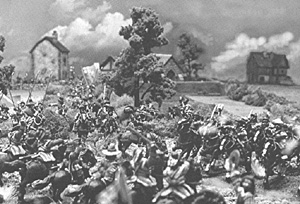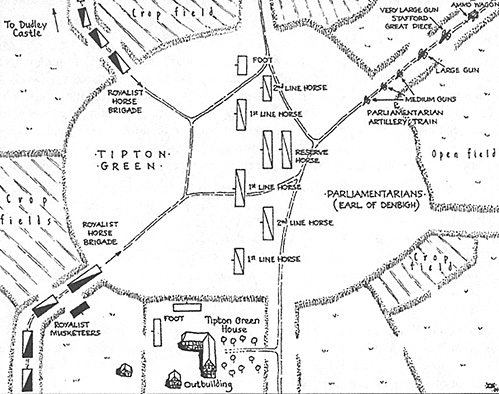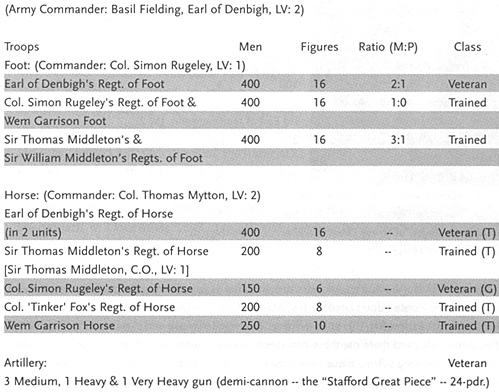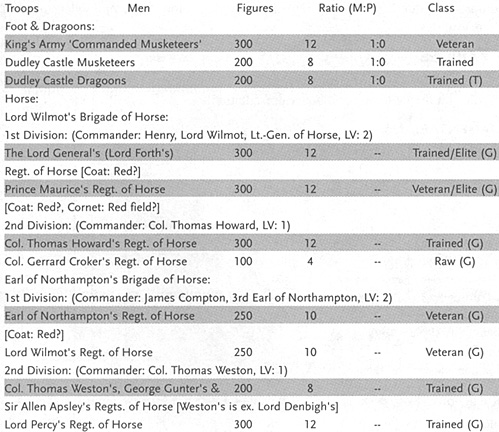 "I had rather lose ten lives than one piece of my artillerie".
"I had rather lose ten lives than one piece of my artillerie".
- -- Basil Fielding, Earl of Denbigh
OVERVIEW
The English Civil War (ECW) period has always attracted me both as a historical miniature gamer and living history re-enactor (www.ecwsa.org). In reality, the ECW spanned all four Kingdoms of Britain (England, Ireland, Scotland and Wales), and spread as far as the Americas. Therefore, this period includes the actions of the Irish and Scottish Rebellions, along with actions in the American Colonies, the Caribbean, and in Europe during the British Commonwealth and Republican periods to the Restoration. Still, the color and military panache of the period, and the seventeenth century in general is a fascinating one, along with the land battles, pirates and privateers ruled the oceans.
This scenario is from my recently released 68-page booklet: English Civil War Scenarios, Vol. II, published by Partizan Press in the UK (see ad elsewhere), and available in the US from On Military Matters (www.onmilitarymatters.com).
It is written to be basic to most standard army level rules sets now available for the period such as Forlorn Hope (also from Partizan Press), Warhammer English Civil War Battles, For King And Country, etc. Yet could quite easily be modified and played with rules sets designed for company level units (such as File Leader). However, by all means, feel free to change as desired. In the end a fun game should prevail, as after all, this is a hobby, and hobbies are suppose to be fun, else why do them!
If you have any questions, or constructive comments, please feel free to contact me, via either the ForlornHope or WECW Yahoogroups, or directly at ECWCaptain@AOL.Com. For those interested, this fall I will be running ECW games at the following two conventions: NOVAGCON (www.novag.org) in Lanham, MD on Oct. 9th, and FALL IN! (www.fall-in.org) in Gettysburg, PA, Nov. 12-14th.
BACKGROUND
Prince Rupert had taken 200-300 horse from the Dudley Castle garrison (along with its governor, Colonel Thomas Leveson, "a man of dangerous temper and devout Catholic faith") for his 1644 Northern Campaign. This did not go unnoticed by Basil Fielding, the Earl of Denbigh, from his Parliamentarian base at Coventry. Reinforced by Sir Thomas Middleton and forces recently raised in the London area, he planned to remove Royalists from South Staffordshire once and for all.
First, Denbigh advanced on Rushall Hall with about 1,000 foot and 750 horse, plus artillery, including a demi-cannon captured from the Royalists at Stafford (who had called it "Roaring Meg", and had used it at the battle of Hopton Heath, 19 March 1643), and renamed the "Stafford Great Piece". He bombarded the Royalist garrison, forcing it to surrender on May 29th, 1644.
After being reinforced by Colonel `Jovial Tinker' Fox's Regiment of Horse, along with foot and horse form the Wem garrison under Col. Thomas Mytton, by June 2nd with about 2,000 men, he felt strong enough to attack Dudley Castle. Denbigh wrote to the Committee of Both Kingdoms that he was in:
- "Great want of arms and money which have brought me into so many perplexities and my soldiers into such heights of mutiny that officers are daily exposed to great hazards. My forces lie about Dudley Castle, which with the assistance of the Country I hope to reduce and at the same time I intend to call in the people to increase both my Horse and Foot, and to keep them ready to move upon your further orders."
While a very well fortified and strong Royalist position, it could not hold out for long, especially against the "Stafford Great Piece" and forces arrayed against it. However, relief would soon be coming.
King Charles I left Oxford on June 3rd, as armies of the Earl of Essex and Sir William Waller closed in. By the 6th he was at Worcester, and dispatched about 2,000 horse under command of Henry, Lord Wilmot, his gallant and popular Lt.-General of Horse, to relieve Dudley Castle.
Denbigh dispatched a strong force under Colonel Thomas Mytton to intercept this fast approaching relief force. Mytton engaged the advance guard as they crossed Pensnett Chase towards evening of the 11th. After a "sharp engagement" and taking some prisoners, Wilmot called it off for the night.
Denbigh lifted the siege and retired under cover of darkness, but ran afoul of terrain. The summer of 1644 was a wet one, and soft ground in the area caused problems in moving artillery quickly. As a result, at dawn the following day his artillery was only about "half a musket shott" away from Dudley Castle, in a muddy lane where the "Stafford Great Piece" had broken down (probably a wheel came off the carriage). However, he did not want to abandon it, stating that ` I had rather lose ten lives than one piece of my artillerie".
THE BATTLE
Denbigh's column repaired the "Stafford Great Piece", but had not gotten far when the relief force was sighted, and was forced to draw up on Tipton Green, about three-quarters of a mile from Dudley Castle, to face the Cavaliers.
After being reinforced by a large force from Dudley Castle, Wilmot advanced to battle. Which began as Royalist musketeers seized Tipton Green House from the Parliamentarians, while about 300 horse with musketeer support approached from the lane leading from Dudley Castle. Wilmot immediately charged with the initial Royalist horse entering the green. This successfully broke through the first line of Parliamentarian horse, then a second charge by Wilmot broke another body of horse that had been coming up to support. Denbigh ordered his reserve to counter-attack, which forced the Royalists back and probably disrupted the rest of their units trying to deploy onto Tipton Green. Meanwhile, Colonel Simon Rugely led an attack with his foot regiment against Tipton Green House, retaking it.
At this crucial stage, apparently Wilmot saw that the Parliamentarians wanted to withdraw rather than fight. Since his orders were to relieve Dudley Castle (i.e., force besiegers to withdraw), and since he had upwards of 2,000 of the best horse from the King's Army, he thought his mission a success and withdrew. What may have played on Wilmot's mind was that he dared not stay any longer for fear that he, and the horse under his command, may be needed if Sir William Waller's Army caught up with the King.
AFTER THE BATTLE
Wilmot and his relief force reached Kidderminster that night, and Bewdley by the 14th, in time to attend the King's Council of War. Denbigh marched off to Walsall, not resuming the siege, but eventually joined with Waller's Army. However, his forces returned to the Midlands when Waller's Army moved to Cropredy Bridge (Waller could have certainly used these forces against the King at Cropredy Bridge; a great 'what-if'!)
Denbigh reported Tipton Green a "major victory", several hundred Royalists killed, the rest routed. Some Parliamentarian accounts (falsely) reported Wilmot was slain as well. However, Denbigh also admitted in his report that Parliamentarian casualties were one officer and ten men killed, and a cornet captured, and that "some offices (officers) of mine were taken prisoner but not in the fight". Interestingly, he was called to London to answer charges of disloyalty and irregular conduct as brought by other local Parliamentarian leaders in July 1644.
Lord Wilmot's wild ride to relieve Dudely Castle indeed ended up breaking the siege, but the battle was technically a draw, due to the weakened state of the King's Army, causing his hurried return.
THE GAME
Chiefly a cavalry engagement on relatively open terrain though hedged on the borders, with some infantry support (mainly for the Parliamentarians), giving a fairly good fight, as sides are well-matched. However, Royalists will be hard pressed to achieve their victory conditions in allotted time, with likely outcome being a historical draw.
While both sides are about equal in numbers - about 2,000 men each - their composition is altogether different. The Royalists are chiefly comprised of horse, while the Parliamentarians are about equally balanced in foot and horse, though the horse are certainly not as numerous or as experienced. Although the Parliamentarians also have artillery, contemporary accounts make no mention of this having been used in the battle. However, depending on circumstances (and players!), these easily could be used in the scenario, given time to properly deploy.
During play-tests it was found that Parliamentarians must initially adopt a defensive posture, letting Royalists be aggressive and advance across the green, thereby allowing their foot to get flanking fire on them from Tipton Green House. Then chose the right time to use their numerous deployed units (at the start) to hit the Royalist horse before all of it can properly deploy. Naturally, as it is a game, die rolls will effect the outcome regardless, and therefore it could easily turn into a total rout for the Roundheads, with the Cavaliers winning the day if things go badly!
PARLIAMENTARIAN DEPLOYMENT AND VICTORY CONDITIONS
Formed up on Tipton Green, with artillery still moving along muddy road, not having had time to properly deploy it.
Deployment is conjecture, with horse in two lines and small reserve; first line no farther forward than even with Tiption Green House, and at least two cavalry moves from Royalists. One (or optionally two) foot units should start in Tipton Green House grounds (good position for flanking fire!) Rest deployed in line to give supporting fire to help break up Royalist charges, or guarding artillery, as desired.
Objective, hold off Royalists long enough so artillery can be gotten safely down lane leading past Tipton Green House and off tabletop for `Minor Victory'. `Major Victory' if they also rout or cause 50% or more casualties to Royalists. However, if artillery is lost, a `Major Defeat' (considering how much Denbigh cherished it!) Artillery is valuable and may not be left to see outcome of battle, as some of the best Royalist horse and commanders are here; it must be gotten safely away, and quickly - do not dally!
ROYALIST DEPLOYMENT AND VICTORY CONDITIONS
Probably advanced down two adjacent lanes entering Tipton Green (one leading from Dudley Castle) in `Column' (only 2 figures wide), with Lord Wilmot leading. Each brigade starts with lead unit just entering Tipton Green on turn I . While forces are detailed on map, actual arrangement (i.e., order of units) is as desired.
Foot may either advance along lane, entering same side of green as Tipton Green House, or deploy in hedged-fields adjacent, heading towards House. Certainly at least one body of musketeers were detailed to seize House (good flanking position to fire from!)
Historically, prior to the battle the Royalist relief force was supported by reinforcements from Dudley Castle (possibly musketeers or dragoons, or both). For purposes of this scenario, a unit each of musketeers and dragoons from the garrison are part of whichever horse brigade is entering along lane from castle. Musketeers can either advance along with column, or mounted and riding behind dragoons (i.e., doubled-up, a tactic used often for a "flying column" in the period). To dismount musketeers consider as dragoons (i.e., formation change, depending on rules set used).
Parliamentarians could easily resume the siege if not beaten soundly. Therefore, for a `Minor Victory' Royalists must either rout 50% or more of enemy's units, or cause 50% or more casualties to them, or combination of both. Capturing artillery is a `Major Victory', considering how much Denbigh cherished it (as compared to his men!) If Royalists suffer over 50% casualties, then any `Major Victory' is reduced to a minor, and likewise a `Minor Victory' to a defeat. Naturally, if either Wilmot or Northampton are lost - killed, mortally wounded, or captured - then it is a defeat (major defeat if both lost), and would be especially hard felt in the King's Army at Cropredy Bridge!
GAME LENGTH
Royalists have initiative turn 1 (if appropriate to rules set used). However, they are on a strict timetable; Wilmot knows he must relieve Dudley Castle, but cannot stay away from the King with 2,000 of his best horse too long. Therefore game lasts 10, plus 1d6, random turns. If objectives not achieved then automatically withdraws to ride back to the King. Random turns are determined as follows.
Beginning turn 11, roll 1d6; if result is equal to a 'I' then Wilmot decides it is time to withdraw, otherwise battle continues. If battle continues, beginning turn 12 another ld6 is rolled; if result is a `2' or less then Wilmot withdraws, otherwise battle continues. If battle continues, beginning turn 13, roll another Id6; if result is `3' or less, Wilmot withdraws, otherwise as above. Die roll continues each turn until Wilmot withdraws or turn 16 begins, whichever comes first (e.g., automatically withdraws turn 16), and battle ends.
OPTIONS
The following options allow for some slight modifications to the battle, as well as how it may effect another larger battle.
Royalist Horse
Lord General's Horse has a `Class' rating of Trained/Elite (G). Elite status could be dropped for this battle, since the Lord General, Lord Forth, was not there. (Note: For Warhammer ECW rules, instead of Trained/Elite (G), should be Trained/Rash (G); for Forlorn Hope rules by Partizan Press, leave as-is.]
Royalist Artillery
Dudley Castle garrison could supply a light gun (or possibly two), included with forces entering along lane from castle. Gun crew has `Class' rating of Trained.
Parliamentarian Artillery
Two light guns could be substituted for one medium, and deployed with foot on green, but due to their size, not considered part of the victory conditions if lost (i.e., only medium, large and very large guns count).
Cropredy Bridge Campaign
This battle could be used as part of a mini-campaign of the 1644 Cropredy Bridge Campaign. Royalist casualties carry over to Cropredy Bridge (June 29th). However, since not all casualties would be real losses (i.e., killed and wounded), they are allowed to recover about half the losses to each unit prior to Cropredy Bridge. The following applies to recovery of commanders.
- Any commander lost - killed, mortally wounded or captured - will not be available.
- Seriously wounded have 50/50 chance of fully recovering. Otherwise have a - I reduction to Leadership Value (LV), as they would still be recovering from a slight (light) wound.
- Lightly wounded recover fully.
GENERAL NOTES
Commander Ratings
One thing that is included, which is not universal to all rule sets, is Army Commander and Commander ratings. After each commander, this is listed as 'LV', for Leadership Value, and followed by a number, from 1-3. This is taken directly from the Forlorn Hope rules. The number is the modifier that the commander adds to a unit's close combat and morale, if attached to the unit (i.e., +1, +2, or +3).
Class Ratings for Units
Most rule sets for the ECW period follow the near-standard conventions of rating units as either `Raw', `Trained', or `Veteran' (note: `Trained' should be considered as `Steady' in Warhammer ECW rules). However, some vary in the way they treat `Elite' units. I followed the `Class' rating system in Forlorn Hope, in that Elite is not a higher level above Veteran, but instead gives a bonus in some categories, and therefore can be applied to any unit, from Raw to Veteran, depending on the circumstances. The following (modified) definition of `Elite' from the Forlorn Hope rules should explain this well enough:
- "Elite - Troops who for various reasons believe themselves to be above average, whether justified or not. This designation differs. from the others in that it is in addition to the above (i.e., `Raw', `Trained', `Veteran'). Thus a unit may be Raw/Elite, Trained/Elite, or Veteran/Elite. Elite units retain their status and all its advantages for only as long as they remain unbeaten in melee, or until forced to retreat as a result of a Morale Check or Test. Elite status is then lost until the unit is able to Rally. However, should the unit be Raw/Elite, Elite status cannot he regained for the rest of the battle."
With regard to `Class' ratings of units, if players and/or gamemaster do not agree with ratings of various units, given year and specific details of battle involved, then they are certainly free to change them. However, scenario play balance was achieved using those as listed, but offers one or more options.
For `Class' ratings of horse units: (G) = Gallopers and (T) = Trotters.
Victory & Defeat
While some goals are provided (i.e., a win or loss) for this scenario. One thing to remember, is that wargaming is a hobby, and as such fun and enjoyment are the key aspects to take away from having played a game, not whether you were a winner or loser (everyone's a winner!)
 THE TERRAIN
THE TERRAIN
Map was developed using what contemporary information is known about engagement, with rest conjectured, but using logical assumptions based on accounts. Details were adjusted to working on a tabletop for a game representing the battle, as opposed to a setin-stone actual depiction of the engagement itself. Feel free to adjust to suit size of tabletop available. While scenarios were designed to fit a 5-foot by 8-foot (or 10-foot) area, slight altering will make them easily work for smaller, as well as larger ones.
Terrain in the ECW period is more an asset then a hindrance, which for the wargamer helps give full expression to ones latent tactical genius, as well as the `artist' in all of us gamemasters in creating a tabletop battlefield on which to play out the scenarios.
TIPTON GREEN
Was circular and surrounded by hedges. Probably a relatively open flat area (no movement penalties) with scattered bits of shrub and such, encompassing center of tabletop, entirely surrounded by "quicksets" (hedges) that bordered its narrow lanes that lead into and across it. All lanes should only be wide enough for allowing two figures in `Column' to move along and once outside green itself should be tightly hedge lined. Green should be large enough on tabletop, with placement of Tipton Green House, so Parliamentarian forces are at least two cavalry moves away from Royalists.
HEDGEROWS & FIELDS
Hedged fields around Tipton Green should vary from open pasture to crop fields (on map, some crop fields have been strategically placed). Remember to place some trees at various points scattered along amongst the hedgerows (to give it that proper English look!) English hedgerows are much thicker than in America (at least provide soft cover).
Hedgerows and fields should hinder movement and cause disorder (any unit in open order should not be as penalized, but still disordered). Disordered units should receive a penalty in both firearms and close combat (i.e., half effective). This reflects unit is not as prepared in their advance or charge as if traversing firm open ground (like would be the case on Tipton Green itself).
TIPTON GREEN HOUSE
One large building (the house or manor itself), and one or more out buildings, along one side of Tipton Green. Grounds should be enclosed with a hedge, with a gate and a few trees along the closely hedge-lined lane. Buildings should give hard or heavy cover. Area that comprises grounds should be represented on tabletop to accommodate about 24 (25/28mm) figures.
THE FORCES
Figure scale for this scenario, given size of forces involved, is a 1:25 ratio. This allows for more figures on the tabletop for a better presentation.
PARLIAMENTARIAN
Historically: About 1200 foot, 1200 horse, and 5 artillery pieces, as follows.
(Army Commander: Basil Fielding, Earl of Denbigh, LV: 2)

Notes: While composition of the Parliamentarian force is basically drawn from the Earl of Denbigh's own account, the rest was added using logical conjecture, to develop a reasonable list for purposes of this scenario. Likewise the actual commanders of the foot and horse is unknown. However, since Colonel Thomas Mytton was noted in the account as leading a cavalry force to intercept the Royalists the day before the battle, and Colonel Simon Rugeley was noted as leading a counter-attack with foot during the battle, these officers were assigned to command the horse and foot, respectively. Denbigh's Horse divided into two equal squadrons (i.e., 2 units).
Artillery number and sizes of guns is conjecture, as none were noted in contemporary accounts, except for the demi-cannon.
ROYALIST
Historically: About 700 foot and dragoons, and 2000 horse, as follows.
(Army Commander: Henry, Lord Wilmot, Lt.-General of Horse, LV: 2)

Notes: Wilmot's and Northampton's brigades are the same as later used at Cropredy Bridge. It was a common tactic (like Prince Rupert used for his "Masterstroke", the relief of Newark; another scenario in ECW Wargaming Scenarios, Vol. II!), to have some 'commanded musketeers' riding behind horse troopers in 'flying columns', and therefore these have been included. While no indication from which exact foot regiments of the King's Army these were drawn from, a composite of available units was used. Since at this stage in the Civil War Royalist morale was high, this has been reflected in the 'Class' of some of the units, especially horse
SOURCES AND RECOMMENDED READING
Blocksidge & Robinson. Dudley During The Civil War. Dudley Almanack. 1893-96.
Carr, Ivor & Eileen. The Battle of Tipton Green. ECW Notes and Queries, Iss. 31. Partizan Press.
Earl of Clarendon. The History of the Rebellion and Civil Wars in England. Oxford University Press. 1843.
Guttery. D. R. The Great Civil War In The Midland Parishes. Cornish. 1950. Hutton, Ronald. The Royalist War Effort, 1642-1646. Routledge. 1999. Reid, Stuart. All The King's Armies. Spellmount Ltd. 1998.
Sherwood, Roy. The Civil War in the Midlands, 1642-1651. Sutton Publishing. 1997 (originally published in 1974 as Civil Strife in the Midlands 1642-1651).
Toynbee, Margaret & Young, Peter. Cropredy Bridge, 1644: The Campaign & The Battle. Roundwood Press. 1970.
Back to MWAN # 131 Table of Contents
Back to MWAN List of Issues
Back to MagWeb Magazine List
© Copyright 2004 Legio X
This article appears in MagWeb.com (Magazine Web) on the Internet World Wide Web.
Other articles from military history and related magazines are available at http://www.magweb.com